A Study on Bullying and Employee Relations in NZ Workplaces
VerifiedAdded on 2020/04/01
|10
|3074
|273
Report
AI Summary
This report provides a comprehensive literature review on workplace bullying, focusing on the New Zealand context. It defines bullying, explores its impact on employees, and examines different types of bullying such as prejudicial, sexual, cyber, relational, and verbal bullying. The report highlights the increasing rates of bullying in NZ companies, citing examples and cases, and discusses the financial and legal implications for businesses. It also presents various recommendations for addressing and preventing bullying, including promoting a positive workplace culture, implementing zero-tolerance policies, providing training and development programs, encouraging open communication, and managing risks and stressors. The conclusion emphasizes the severity of workplace bullying and the importance of proactive measures by both management and employees to create a healthier and more productive work environment.
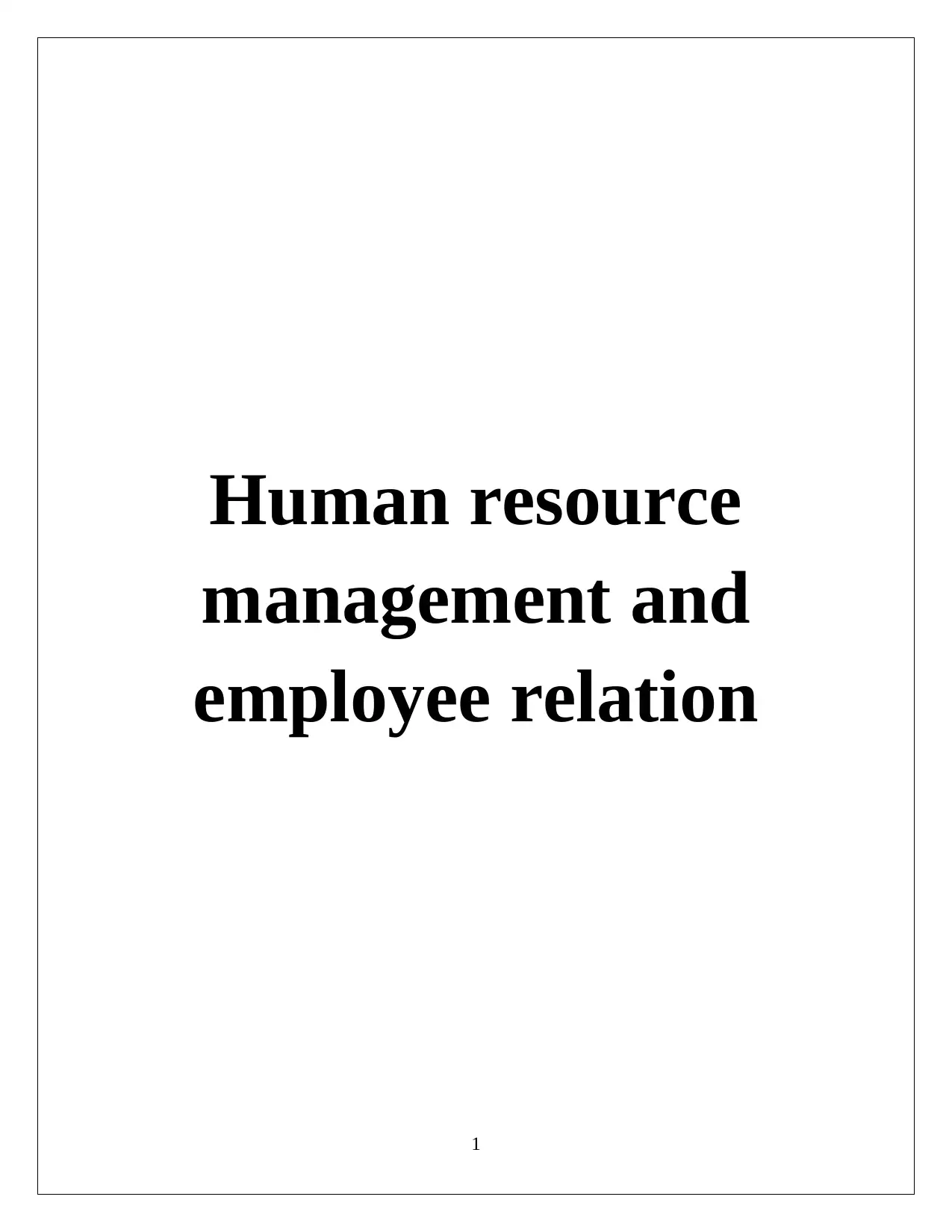
Human resource
management and
employee relation
1
management and
employee relation
1
Paraphrase This Document
Need a fresh take? Get an instant paraphrase of this document with our AI Paraphraser
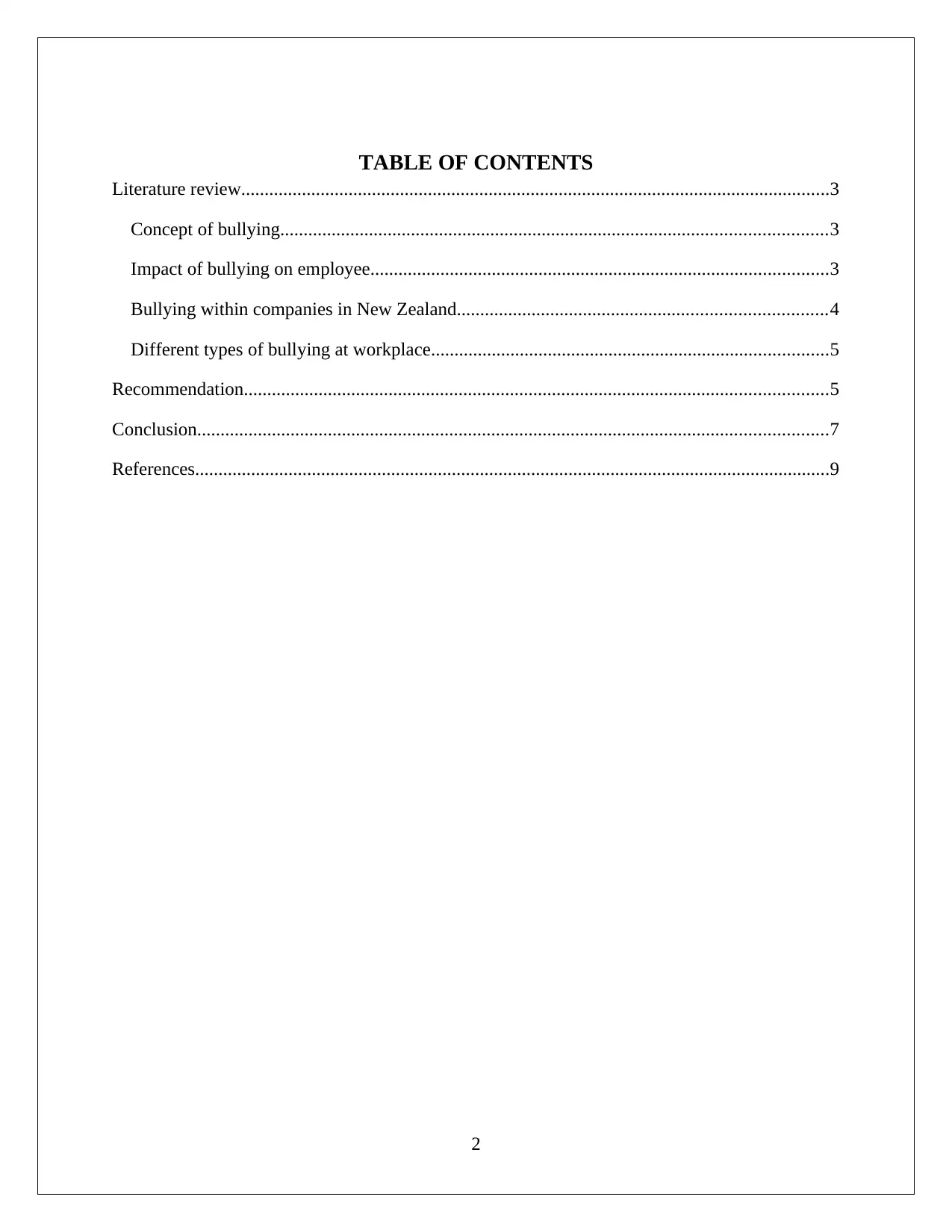
TABLE OF CONTENTS
Literature review..............................................................................................................................3
Concept of bullying.....................................................................................................................3
Impact of bullying on employee..................................................................................................3
Bullying within companies in New Zealand...............................................................................4
Different types of bullying at workplace.....................................................................................5
Recommendation.............................................................................................................................5
Conclusion.......................................................................................................................................7
References........................................................................................................................................9
2
Literature review..............................................................................................................................3
Concept of bullying.....................................................................................................................3
Impact of bullying on employee..................................................................................................3
Bullying within companies in New Zealand...............................................................................4
Different types of bullying at workplace.....................................................................................5
Recommendation.............................................................................................................................5
Conclusion.......................................................................................................................................7
References........................................................................................................................................9
2
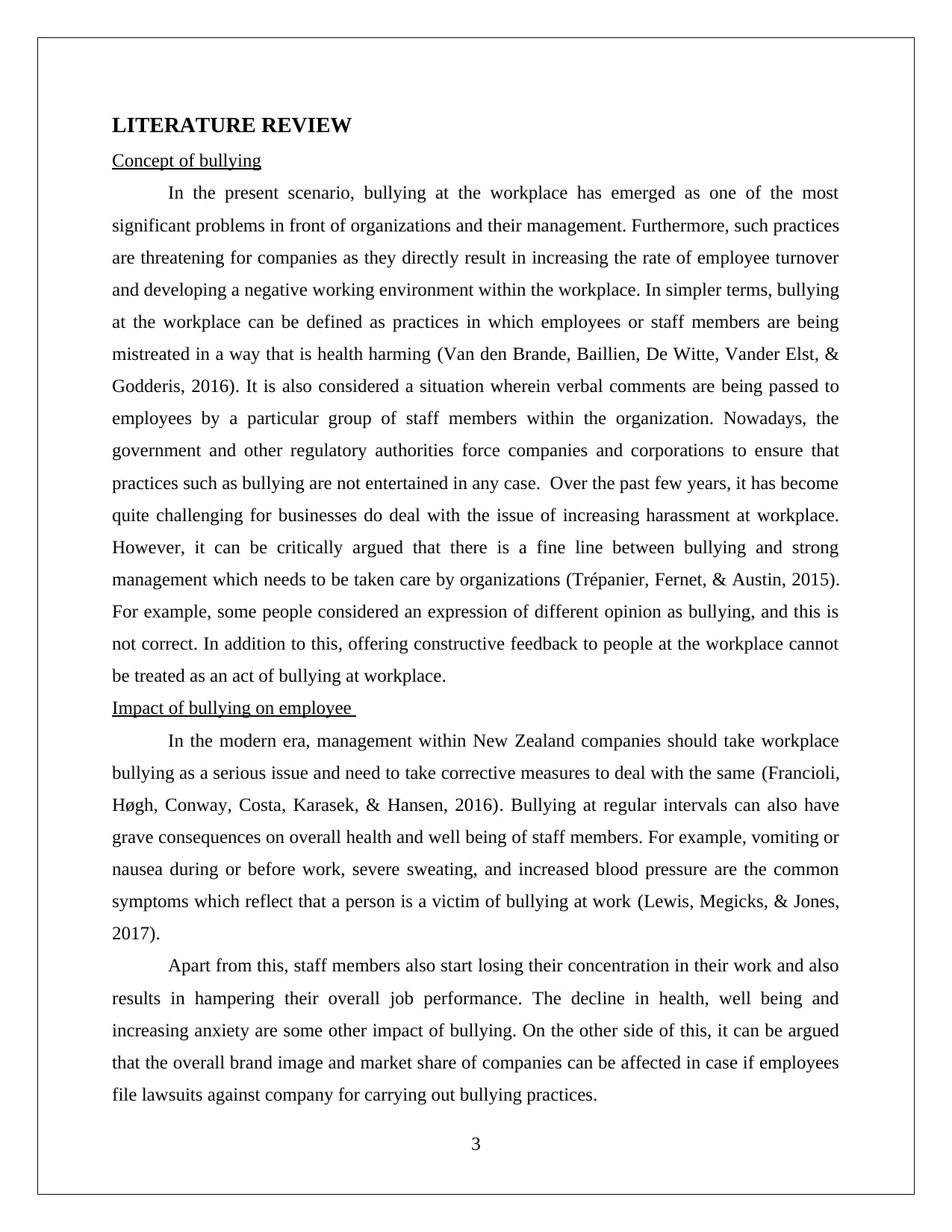
LITERATURE REVIEW
Concept of bullying
In the present scenario, bullying at the workplace has emerged as one of the most
significant problems in front of organizations and their management. Furthermore, such practices
are threatening for companies as they directly result in increasing the rate of employee turnover
and developing a negative working environment within the workplace. In simpler terms, bullying
at the workplace can be defined as practices in which employees or staff members are being
mistreated in a way that is health harming (Van den Brande, Baillien, De Witte, Vander Elst, &
Godderis, 2016). It is also considered a situation wherein verbal comments are being passed to
employees by a particular group of staff members within the organization. Nowadays, the
government and other regulatory authorities force companies and corporations to ensure that
practices such as bullying are not entertained in any case. Over the past few years, it has become
quite challenging for businesses do deal with the issue of increasing harassment at workplace.
However, it can be critically argued that there is a fine line between bullying and strong
management which needs to be taken care by organizations (Trépanier, Fernet, & Austin, 2015).
For example, some people considered an expression of different opinion as bullying, and this is
not correct. In addition to this, offering constructive feedback to people at the workplace cannot
be treated as an act of bullying at workplace.
Impact of bullying on employee
In the modern era, management within New Zealand companies should take workplace
bullying as a serious issue and need to take corrective measures to deal with the same (Francioli,
Høgh, Conway, Costa, Karasek, & Hansen, 2016). Bullying at regular intervals can also have
grave consequences on overall health and well being of staff members. For example, vomiting or
nausea during or before work, severe sweating, and increased blood pressure are the common
symptoms which reflect that a person is a victim of bullying at work (Lewis, Megicks, & Jones,
2017).
Apart from this, staff members also start losing their concentration in their work and also
results in hampering their overall job performance. The decline in health, well being and
increasing anxiety are some other impact of bullying. On the other side of this, it can be argued
that the overall brand image and market share of companies can be affected in case if employees
file lawsuits against company for carrying out bullying practices.
3
Concept of bullying
In the present scenario, bullying at the workplace has emerged as one of the most
significant problems in front of organizations and their management. Furthermore, such practices
are threatening for companies as they directly result in increasing the rate of employee turnover
and developing a negative working environment within the workplace. In simpler terms, bullying
at the workplace can be defined as practices in which employees or staff members are being
mistreated in a way that is health harming (Van den Brande, Baillien, De Witte, Vander Elst, &
Godderis, 2016). It is also considered a situation wherein verbal comments are being passed to
employees by a particular group of staff members within the organization. Nowadays, the
government and other regulatory authorities force companies and corporations to ensure that
practices such as bullying are not entertained in any case. Over the past few years, it has become
quite challenging for businesses do deal with the issue of increasing harassment at workplace.
However, it can be critically argued that there is a fine line between bullying and strong
management which needs to be taken care by organizations (Trépanier, Fernet, & Austin, 2015).
For example, some people considered an expression of different opinion as bullying, and this is
not correct. In addition to this, offering constructive feedback to people at the workplace cannot
be treated as an act of bullying at workplace.
Impact of bullying on employee
In the modern era, management within New Zealand companies should take workplace
bullying as a serious issue and need to take corrective measures to deal with the same (Francioli,
Høgh, Conway, Costa, Karasek, & Hansen, 2016). Bullying at regular intervals can also have
grave consequences on overall health and well being of staff members. For example, vomiting or
nausea during or before work, severe sweating, and increased blood pressure are the common
symptoms which reflect that a person is a victim of bullying at work (Lewis, Megicks, & Jones,
2017).
Apart from this, staff members also start losing their concentration in their work and also
results in hampering their overall job performance. The decline in health, well being and
increasing anxiety are some other impact of bullying. On the other side of this, it can be argued
that the overall brand image and market share of companies can be affected in case if employees
file lawsuits against company for carrying out bullying practices.
3
⊘ This is a preview!⊘
Do you want full access?
Subscribe today to unlock all pages.

Trusted by 1+ million students worldwide
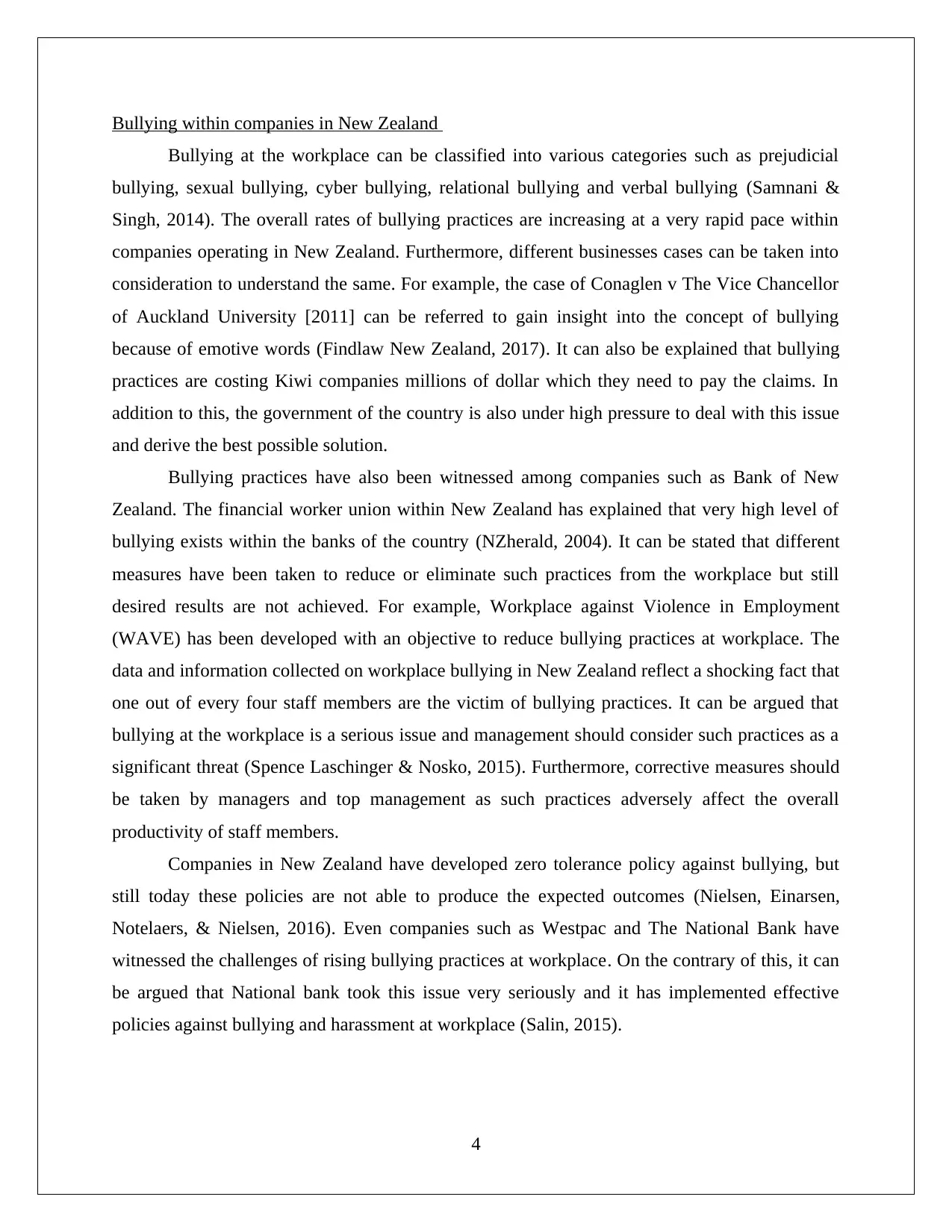
Bullying within companies in New Zealand
Bullying at the workplace can be classified into various categories such as prejudicial
bullying, sexual bullying, cyber bullying, relational bullying and verbal bullying (Samnani &
Singh, 2014). The overall rates of bullying practices are increasing at a very rapid pace within
companies operating in New Zealand. Furthermore, different businesses cases can be taken into
consideration to understand the same. For example, the case of Conaglen v The Vice Chancellor
of Auckland University [2011] can be referred to gain insight into the concept of bullying
because of emotive words (Findlaw New Zealand, 2017). It can also be explained that bullying
practices are costing Kiwi companies millions of dollar which they need to pay the claims. In
addition to this, the government of the country is also under high pressure to deal with this issue
and derive the best possible solution.
Bullying practices have also been witnessed among companies such as Bank of New
Zealand. The financial worker union within New Zealand has explained that very high level of
bullying exists within the banks of the country (NZherald, 2004). It can be stated that different
measures have been taken to reduce or eliminate such practices from the workplace but still
desired results are not achieved. For example, Workplace against Violence in Employment
(WAVE) has been developed with an objective to reduce bullying practices at workplace. The
data and information collected on workplace bullying in New Zealand reflect a shocking fact that
one out of every four staff members are the victim of bullying practices. It can be argued that
bullying at the workplace is a serious issue and management should consider such practices as a
significant threat (Spence Laschinger & Nosko, 2015). Furthermore, corrective measures should
be taken by managers and top management as such practices adversely affect the overall
productivity of staff members.
Companies in New Zealand have developed zero tolerance policy against bullying, but
still today these policies are not able to produce the expected outcomes (Nielsen, Einarsen,
Notelaers, & Nielsen, 2016). Even companies such as Westpac and The National Bank have
witnessed the challenges of rising bullying practices at workplace. On the contrary of this, it can
be argued that National bank took this issue very seriously and it has implemented effective
policies against bullying and harassment at workplace (Salin, 2015).
4
Bullying at the workplace can be classified into various categories such as prejudicial
bullying, sexual bullying, cyber bullying, relational bullying and verbal bullying (Samnani &
Singh, 2014). The overall rates of bullying practices are increasing at a very rapid pace within
companies operating in New Zealand. Furthermore, different businesses cases can be taken into
consideration to understand the same. For example, the case of Conaglen v The Vice Chancellor
of Auckland University [2011] can be referred to gain insight into the concept of bullying
because of emotive words (Findlaw New Zealand, 2017). It can also be explained that bullying
practices are costing Kiwi companies millions of dollar which they need to pay the claims. In
addition to this, the government of the country is also under high pressure to deal with this issue
and derive the best possible solution.
Bullying practices have also been witnessed among companies such as Bank of New
Zealand. The financial worker union within New Zealand has explained that very high level of
bullying exists within the banks of the country (NZherald, 2004). It can be stated that different
measures have been taken to reduce or eliminate such practices from the workplace but still
desired results are not achieved. For example, Workplace against Violence in Employment
(WAVE) has been developed with an objective to reduce bullying practices at workplace. The
data and information collected on workplace bullying in New Zealand reflect a shocking fact that
one out of every four staff members are the victim of bullying practices. It can be argued that
bullying at the workplace is a serious issue and management should consider such practices as a
significant threat (Spence Laschinger & Nosko, 2015). Furthermore, corrective measures should
be taken by managers and top management as such practices adversely affect the overall
productivity of staff members.
Companies in New Zealand have developed zero tolerance policy against bullying, but
still today these policies are not able to produce the expected outcomes (Nielsen, Einarsen,
Notelaers, & Nielsen, 2016). Even companies such as Westpac and The National Bank have
witnessed the challenges of rising bullying practices at workplace. On the contrary of this, it can
be argued that National bank took this issue very seriously and it has implemented effective
policies against bullying and harassment at workplace (Salin, 2015).
4
Paraphrase This Document
Need a fresh take? Get an instant paraphrase of this document with our AI Paraphraser
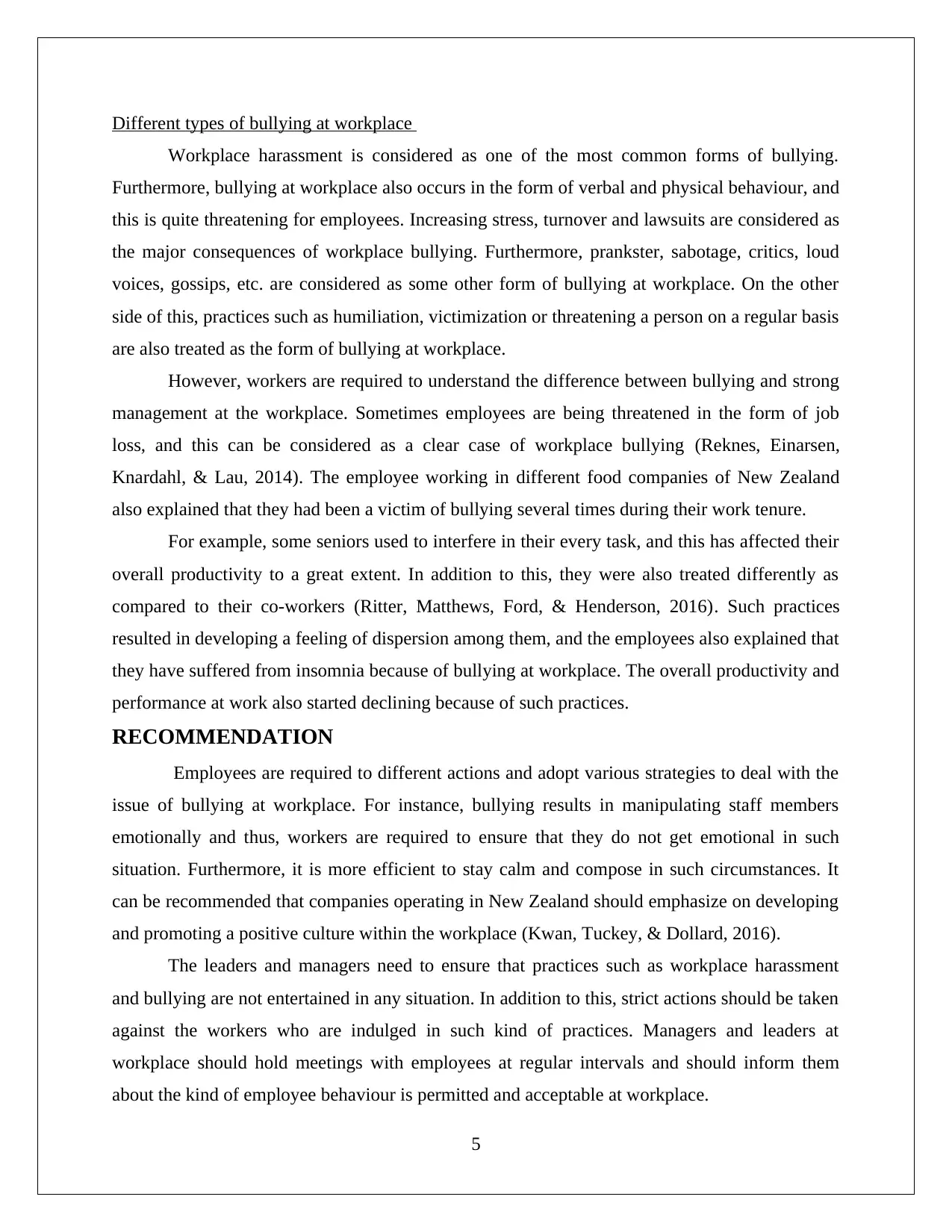
Different types of bullying at workplace
Workplace harassment is considered as one of the most common forms of bullying.
Furthermore, bullying at workplace also occurs in the form of verbal and physical behaviour, and
this is quite threatening for employees. Increasing stress, turnover and lawsuits are considered as
the major consequences of workplace bullying. Furthermore, prankster, sabotage, critics, loud
voices, gossips, etc. are considered as some other form of bullying at workplace. On the other
side of this, practices such as humiliation, victimization or threatening a person on a regular basis
are also treated as the form of bullying at workplace.
However, workers are required to understand the difference between bullying and strong
management at the workplace. Sometimes employees are being threatened in the form of job
loss, and this can be considered as a clear case of workplace bullying (Reknes, Einarsen,
Knardahl, & Lau, 2014). The employee working in different food companies of New Zealand
also explained that they had been a victim of bullying several times during their work tenure.
For example, some seniors used to interfere in their every task, and this has affected their
overall productivity to a great extent. In addition to this, they were also treated differently as
compared to their co-workers (Ritter, Matthews, Ford, & Henderson, 2016). Such practices
resulted in developing a feeling of dispersion among them, and the employees also explained that
they have suffered from insomnia because of bullying at workplace. The overall productivity and
performance at work also started declining because of such practices.
RECOMMENDATION
Employees are required to different actions and adopt various strategies to deal with the
issue of bullying at workplace. For instance, bullying results in manipulating staff members
emotionally and thus, workers are required to ensure that they do not get emotional in such
situation. Furthermore, it is more efficient to stay calm and compose in such circumstances. It
can be recommended that companies operating in New Zealand should emphasize on developing
and promoting a positive culture within the workplace (Kwan, Tuckey, & Dollard, 2016).
The leaders and managers need to ensure that practices such as workplace harassment
and bullying are not entertained in any situation. In addition to this, strict actions should be taken
against the workers who are indulged in such kind of practices. Managers and leaders at
workplace should hold meetings with employees at regular intervals and should inform them
about the kind of employee behaviour is permitted and acceptable at workplace.
5
Workplace harassment is considered as one of the most common forms of bullying.
Furthermore, bullying at workplace also occurs in the form of verbal and physical behaviour, and
this is quite threatening for employees. Increasing stress, turnover and lawsuits are considered as
the major consequences of workplace bullying. Furthermore, prankster, sabotage, critics, loud
voices, gossips, etc. are considered as some other form of bullying at workplace. On the other
side of this, practices such as humiliation, victimization or threatening a person on a regular basis
are also treated as the form of bullying at workplace.
However, workers are required to understand the difference between bullying and strong
management at the workplace. Sometimes employees are being threatened in the form of job
loss, and this can be considered as a clear case of workplace bullying (Reknes, Einarsen,
Knardahl, & Lau, 2014). The employee working in different food companies of New Zealand
also explained that they had been a victim of bullying several times during their work tenure.
For example, some seniors used to interfere in their every task, and this has affected their
overall productivity to a great extent. In addition to this, they were also treated differently as
compared to their co-workers (Ritter, Matthews, Ford, & Henderson, 2016). Such practices
resulted in developing a feeling of dispersion among them, and the employees also explained that
they have suffered from insomnia because of bullying at workplace. The overall productivity and
performance at work also started declining because of such practices.
RECOMMENDATION
Employees are required to different actions and adopt various strategies to deal with the
issue of bullying at workplace. For instance, bullying results in manipulating staff members
emotionally and thus, workers are required to ensure that they do not get emotional in such
situation. Furthermore, it is more efficient to stay calm and compose in such circumstances. It
can be recommended that companies operating in New Zealand should emphasize on developing
and promoting a positive culture within the workplace (Kwan, Tuckey, & Dollard, 2016).
The leaders and managers need to ensure that practices such as workplace harassment
and bullying are not entertained in any situation. In addition to this, strict actions should be taken
against the workers who are indulged in such kind of practices. Managers and leaders at
workplace should hold meetings with employees at regular intervals and should inform them
about the kind of employee behaviour is permitted and acceptable at workplace.
5
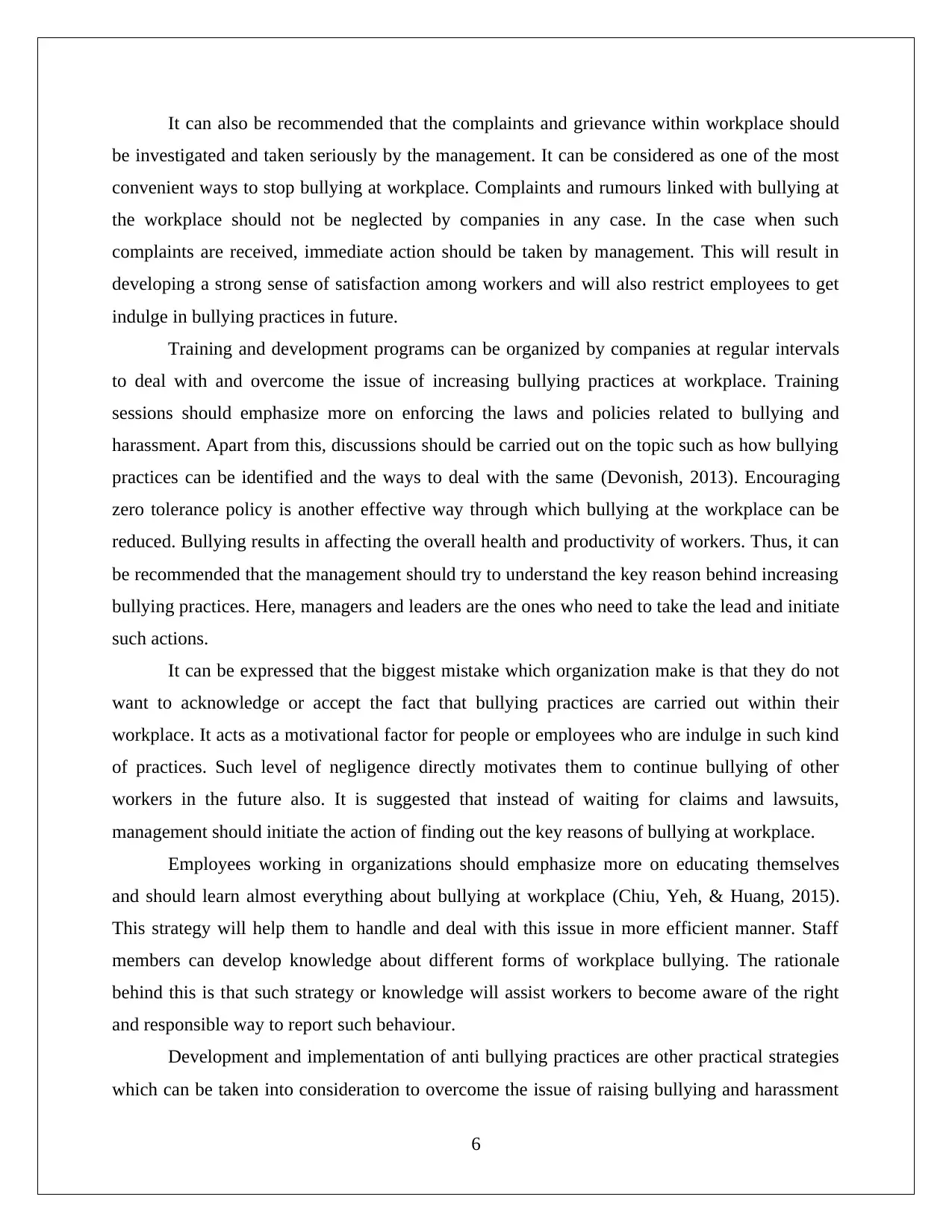
It can also be recommended that the complaints and grievance within workplace should
be investigated and taken seriously by the management. It can be considered as one of the most
convenient ways to stop bullying at workplace. Complaints and rumours linked with bullying at
the workplace should not be neglected by companies in any case. In the case when such
complaints are received, immediate action should be taken by management. This will result in
developing a strong sense of satisfaction among workers and will also restrict employees to get
indulge in bullying practices in future.
Training and development programs can be organized by companies at regular intervals
to deal with and overcome the issue of increasing bullying practices at workplace. Training
sessions should emphasize more on enforcing the laws and policies related to bullying and
harassment. Apart from this, discussions should be carried out on the topic such as how bullying
practices can be identified and the ways to deal with the same (Devonish, 2013). Encouraging
zero tolerance policy is another effective way through which bullying at the workplace can be
reduced. Bullying results in affecting the overall health and productivity of workers. Thus, it can
be recommended that the management should try to understand the key reason behind increasing
bullying practices. Here, managers and leaders are the ones who need to take the lead and initiate
such actions.
It can be expressed that the biggest mistake which organization make is that they do not
want to acknowledge or accept the fact that bullying practices are carried out within their
workplace. It acts as a motivational factor for people or employees who are indulge in such kind
of practices. Such level of negligence directly motivates them to continue bullying of other
workers in the future also. It is suggested that instead of waiting for claims and lawsuits,
management should initiate the action of finding out the key reasons of bullying at workplace.
Employees working in organizations should emphasize more on educating themselves
and should learn almost everything about bullying at workplace (Chiu, Yeh, & Huang, 2015).
This strategy will help them to handle and deal with this issue in more efficient manner. Staff
members can develop knowledge about different forms of workplace bullying. The rationale
behind this is that such strategy or knowledge will assist workers to become aware of the right
and responsible way to report such behaviour.
Development and implementation of anti bullying practices are other practical strategies
which can be taken into consideration to overcome the issue of raising bullying and harassment
6
be investigated and taken seriously by the management. It can be considered as one of the most
convenient ways to stop bullying at workplace. Complaints and rumours linked with bullying at
the workplace should not be neglected by companies in any case. In the case when such
complaints are received, immediate action should be taken by management. This will result in
developing a strong sense of satisfaction among workers and will also restrict employees to get
indulge in bullying practices in future.
Training and development programs can be organized by companies at regular intervals
to deal with and overcome the issue of increasing bullying practices at workplace. Training
sessions should emphasize more on enforcing the laws and policies related to bullying and
harassment. Apart from this, discussions should be carried out on the topic such as how bullying
practices can be identified and the ways to deal with the same (Devonish, 2013). Encouraging
zero tolerance policy is another effective way through which bullying at the workplace can be
reduced. Bullying results in affecting the overall health and productivity of workers. Thus, it can
be recommended that the management should try to understand the key reason behind increasing
bullying practices. Here, managers and leaders are the ones who need to take the lead and initiate
such actions.
It can be expressed that the biggest mistake which organization make is that they do not
want to acknowledge or accept the fact that bullying practices are carried out within their
workplace. It acts as a motivational factor for people or employees who are indulge in such kind
of practices. Such level of negligence directly motivates them to continue bullying of other
workers in the future also. It is suggested that instead of waiting for claims and lawsuits,
management should initiate the action of finding out the key reasons of bullying at workplace.
Employees working in organizations should emphasize more on educating themselves
and should learn almost everything about bullying at workplace (Chiu, Yeh, & Huang, 2015).
This strategy will help them to handle and deal with this issue in more efficient manner. Staff
members can develop knowledge about different forms of workplace bullying. The rationale
behind this is that such strategy or knowledge will assist workers to become aware of the right
and responsible way to report such behaviour.
Development and implementation of anti bullying practices are other practical strategies
which can be taken into consideration to overcome the issue of raising bullying and harassment
6
⊘ This is a preview!⊘
Do you want full access?
Subscribe today to unlock all pages.

Trusted by 1+ million students worldwide
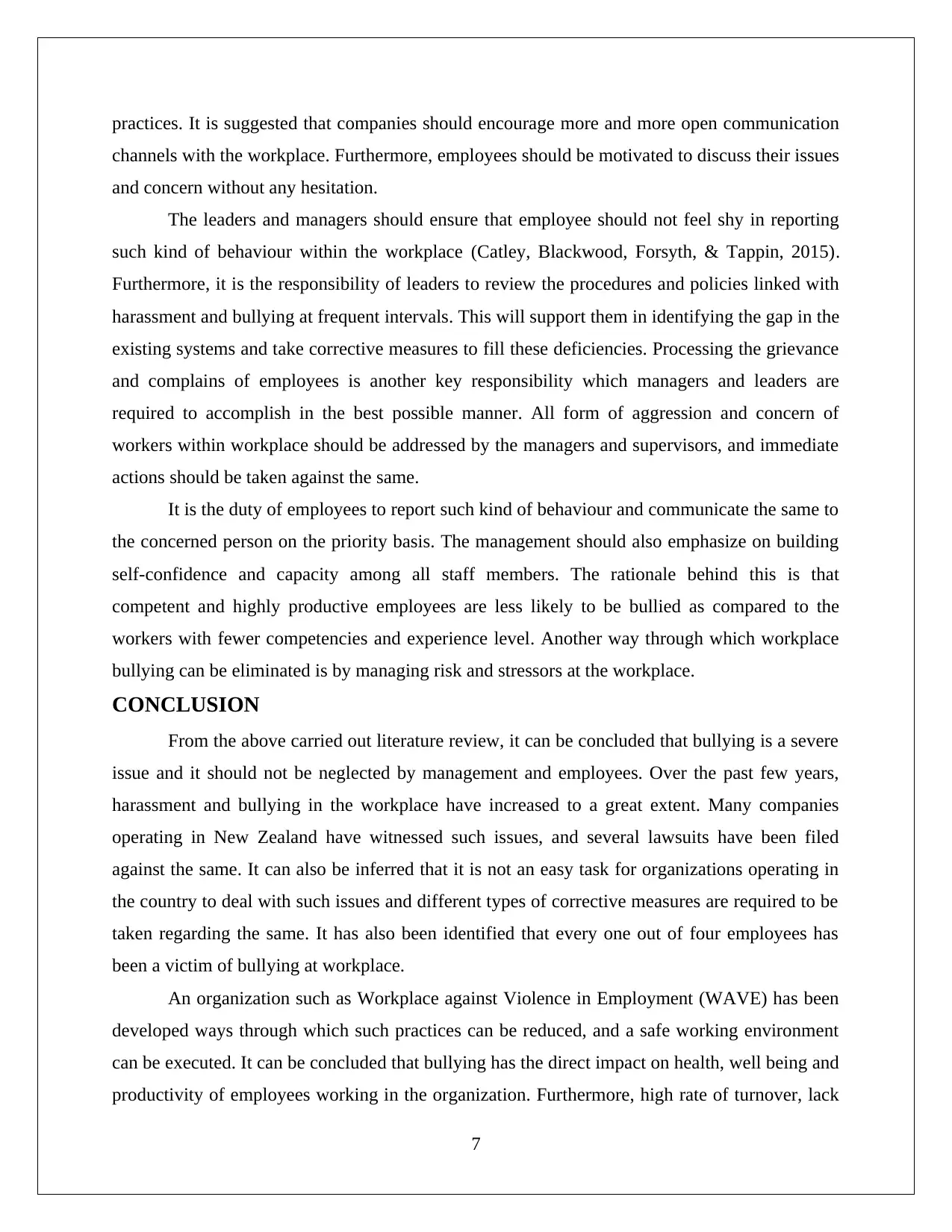
practices. It is suggested that companies should encourage more and more open communication
channels with the workplace. Furthermore, employees should be motivated to discuss their issues
and concern without any hesitation.
The leaders and managers should ensure that employee should not feel shy in reporting
such kind of behaviour within the workplace (Catley, Blackwood, Forsyth, & Tappin, 2015).
Furthermore, it is the responsibility of leaders to review the procedures and policies linked with
harassment and bullying at frequent intervals. This will support them in identifying the gap in the
existing systems and take corrective measures to fill these deficiencies. Processing the grievance
and complains of employees is another key responsibility which managers and leaders are
required to accomplish in the best possible manner. All form of aggression and concern of
workers within workplace should be addressed by the managers and supervisors, and immediate
actions should be taken against the same.
It is the duty of employees to report such kind of behaviour and communicate the same to
the concerned person on the priority basis. The management should also emphasize on building
self-confidence and capacity among all staff members. The rationale behind this is that
competent and highly productive employees are less likely to be bullied as compared to the
workers with fewer competencies and experience level. Another way through which workplace
bullying can be eliminated is by managing risk and stressors at the workplace.
CONCLUSION
From the above carried out literature review, it can be concluded that bullying is a severe
issue and it should not be neglected by management and employees. Over the past few years,
harassment and bullying in the workplace have increased to a great extent. Many companies
operating in New Zealand have witnessed such issues, and several lawsuits have been filed
against the same. It can also be inferred that it is not an easy task for organizations operating in
the country to deal with such issues and different types of corrective measures are required to be
taken regarding the same. It has also been identified that every one out of four employees has
been a victim of bullying at workplace.
An organization such as Workplace against Violence in Employment (WAVE) has been
developed ways through which such practices can be reduced, and a safe working environment
can be executed. It can be concluded that bullying has the direct impact on health, well being and
productivity of employees working in the organization. Furthermore, high rate of turnover, lack
7
channels with the workplace. Furthermore, employees should be motivated to discuss their issues
and concern without any hesitation.
The leaders and managers should ensure that employee should not feel shy in reporting
such kind of behaviour within the workplace (Catley, Blackwood, Forsyth, & Tappin, 2015).
Furthermore, it is the responsibility of leaders to review the procedures and policies linked with
harassment and bullying at frequent intervals. This will support them in identifying the gap in the
existing systems and take corrective measures to fill these deficiencies. Processing the grievance
and complains of employees is another key responsibility which managers and leaders are
required to accomplish in the best possible manner. All form of aggression and concern of
workers within workplace should be addressed by the managers and supervisors, and immediate
actions should be taken against the same.
It is the duty of employees to report such kind of behaviour and communicate the same to
the concerned person on the priority basis. The management should also emphasize on building
self-confidence and capacity among all staff members. The rationale behind this is that
competent and highly productive employees are less likely to be bullied as compared to the
workers with fewer competencies and experience level. Another way through which workplace
bullying can be eliminated is by managing risk and stressors at the workplace.
CONCLUSION
From the above carried out literature review, it can be concluded that bullying is a severe
issue and it should not be neglected by management and employees. Over the past few years,
harassment and bullying in the workplace have increased to a great extent. Many companies
operating in New Zealand have witnessed such issues, and several lawsuits have been filed
against the same. It can also be inferred that it is not an easy task for organizations operating in
the country to deal with such issues and different types of corrective measures are required to be
taken regarding the same. It has also been identified that every one out of four employees has
been a victim of bullying at workplace.
An organization such as Workplace against Violence in Employment (WAVE) has been
developed ways through which such practices can be reduced, and a safe working environment
can be executed. It can be concluded that bullying has the direct impact on health, well being and
productivity of employees working in the organization. Furthermore, high rate of turnover, lack
7
Paraphrase This Document
Need a fresh take? Get an instant paraphrase of this document with our AI Paraphraser
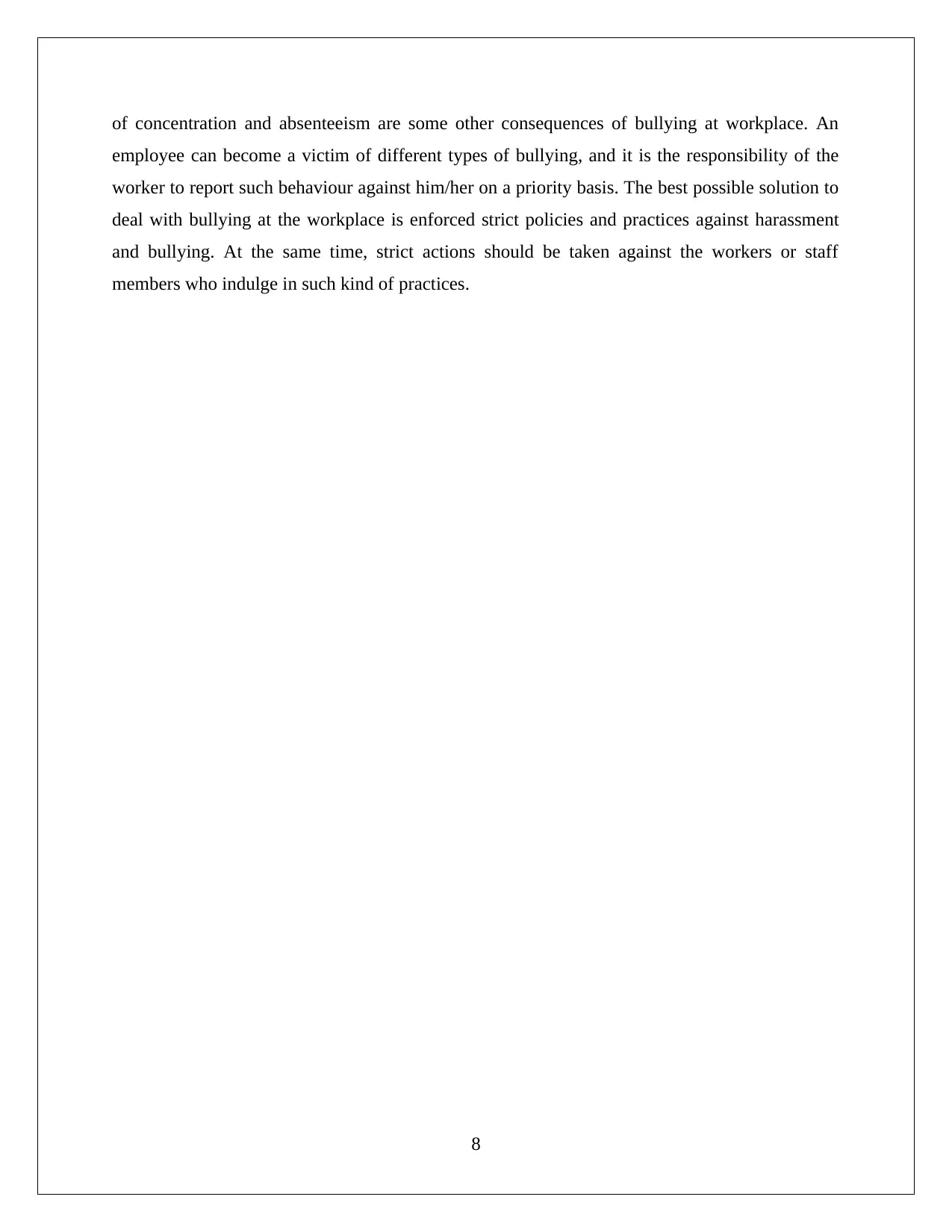
of concentration and absenteeism are some other consequences of bullying at workplace. An
employee can become a victim of different types of bullying, and it is the responsibility of the
worker to report such behaviour against him/her on a priority basis. The best possible solution to
deal with bullying at the workplace is enforced strict policies and practices against harassment
and bullying. At the same time, strict actions should be taken against the workers or staff
members who indulge in such kind of practices.
8
employee can become a victim of different types of bullying, and it is the responsibility of the
worker to report such behaviour against him/her on a priority basis. The best possible solution to
deal with bullying at the workplace is enforced strict policies and practices against harassment
and bullying. At the same time, strict actions should be taken against the workers or staff
members who indulge in such kind of practices.
8
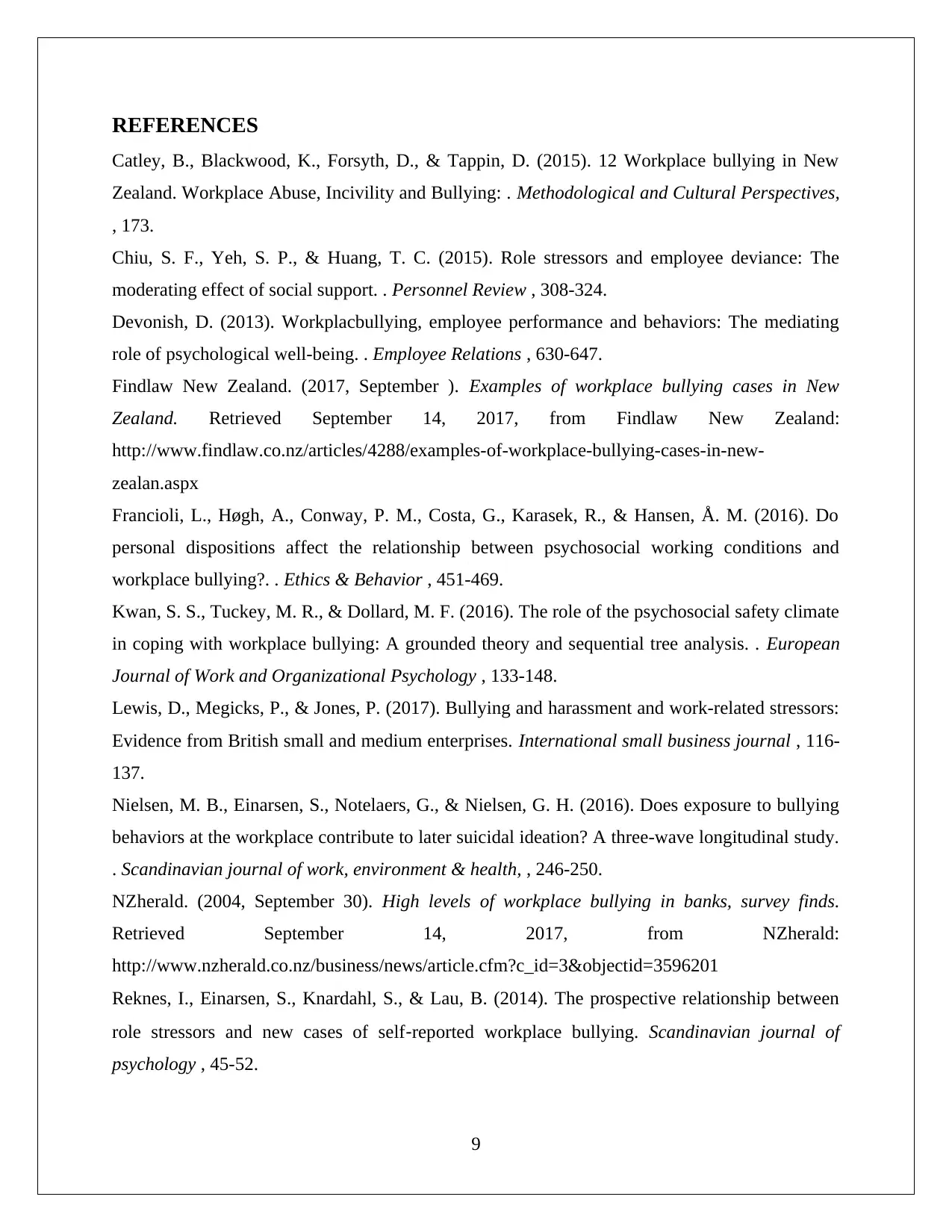
REFERENCES
Catley, B., Blackwood, K., Forsyth, D., & Tappin, D. (2015). 12 Workplace bullying in New
Zealand. Workplace Abuse, Incivility and Bullying: . Methodological and Cultural Perspectives,
, 173.
Chiu, S. F., Yeh, S. P., & Huang, T. C. (2015). Role stressors and employee deviance: The
moderating effect of social support. . Personnel Review , 308-324.
Devonish, D. (2013). Workplacbullying, employee performance and behaviors: The mediating
role of psychological well-being. . Employee Relations , 630-647.
Findlaw New Zealand. (2017, September ). Examples of workplace bullying cases in New
Zealand. Retrieved September 14, 2017, from Findlaw New Zealand:
http://www.findlaw.co.nz/articles/4288/examples-of-workplace-bullying-cases-in-new-
zealan.aspx
Francioli, L., Høgh, A., Conway, P. M., Costa, G., Karasek, R., & Hansen, Å. M. (2016). Do
personal dispositions affect the relationship between psychosocial working conditions and
workplace bullying?. . Ethics & Behavior , 451-469.
Kwan, S. S., Tuckey, M. R., & Dollard, M. F. (2016). The role of the psychosocial safety climate
in coping with workplace bullying: A grounded theory and sequential tree analysis. . European
Journal of Work and Organizational Psychology , 133-148.
Lewis, D., Megicks, P., & Jones, P. (2017). Bullying and harassment and work-related stressors:
Evidence from British small and medium enterprises. International small business journal , 116-
137.
Nielsen, M. B., Einarsen, S., Notelaers, G., & Nielsen, G. H. (2016). Does exposure to bullying
behaviors at the workplace contribute to later suicidal ideation? A three-wave longitudinal study.
. Scandinavian journal of work, environment & health, , 246-250.
NZherald. (2004, September 30). High levels of workplace bullying in banks, survey finds.
Retrieved September 14, 2017, from NZherald:
http://www.nzherald.co.nz/business/news/article.cfm?c_id=3&objectid=3596201
Reknes, I., Einarsen, S., Knardahl, S., & Lau, B. (2014). The prospective relationship between
role stressors and new cases of self‐reported workplace bullying. Scandinavian journal of
psychology , 45-52.
9
Catley, B., Blackwood, K., Forsyth, D., & Tappin, D. (2015). 12 Workplace bullying in New
Zealand. Workplace Abuse, Incivility and Bullying: . Methodological and Cultural Perspectives,
, 173.
Chiu, S. F., Yeh, S. P., & Huang, T. C. (2015). Role stressors and employee deviance: The
moderating effect of social support. . Personnel Review , 308-324.
Devonish, D. (2013). Workplacbullying, employee performance and behaviors: The mediating
role of psychological well-being. . Employee Relations , 630-647.
Findlaw New Zealand. (2017, September ). Examples of workplace bullying cases in New
Zealand. Retrieved September 14, 2017, from Findlaw New Zealand:
http://www.findlaw.co.nz/articles/4288/examples-of-workplace-bullying-cases-in-new-
zealan.aspx
Francioli, L., Høgh, A., Conway, P. M., Costa, G., Karasek, R., & Hansen, Å. M. (2016). Do
personal dispositions affect the relationship between psychosocial working conditions and
workplace bullying?. . Ethics & Behavior , 451-469.
Kwan, S. S., Tuckey, M. R., & Dollard, M. F. (2016). The role of the psychosocial safety climate
in coping with workplace bullying: A grounded theory and sequential tree analysis. . European
Journal of Work and Organizational Psychology , 133-148.
Lewis, D., Megicks, P., & Jones, P. (2017). Bullying and harassment and work-related stressors:
Evidence from British small and medium enterprises. International small business journal , 116-
137.
Nielsen, M. B., Einarsen, S., Notelaers, G., & Nielsen, G. H. (2016). Does exposure to bullying
behaviors at the workplace contribute to later suicidal ideation? A three-wave longitudinal study.
. Scandinavian journal of work, environment & health, , 246-250.
NZherald. (2004, September 30). High levels of workplace bullying in banks, survey finds.
Retrieved September 14, 2017, from NZherald:
http://www.nzherald.co.nz/business/news/article.cfm?c_id=3&objectid=3596201
Reknes, I., Einarsen, S., Knardahl, S., & Lau, B. (2014). The prospective relationship between
role stressors and new cases of self‐reported workplace bullying. Scandinavian journal of
psychology , 45-52.
9
⊘ This is a preview!⊘
Do you want full access?
Subscribe today to unlock all pages.

Trusted by 1+ million students worldwide
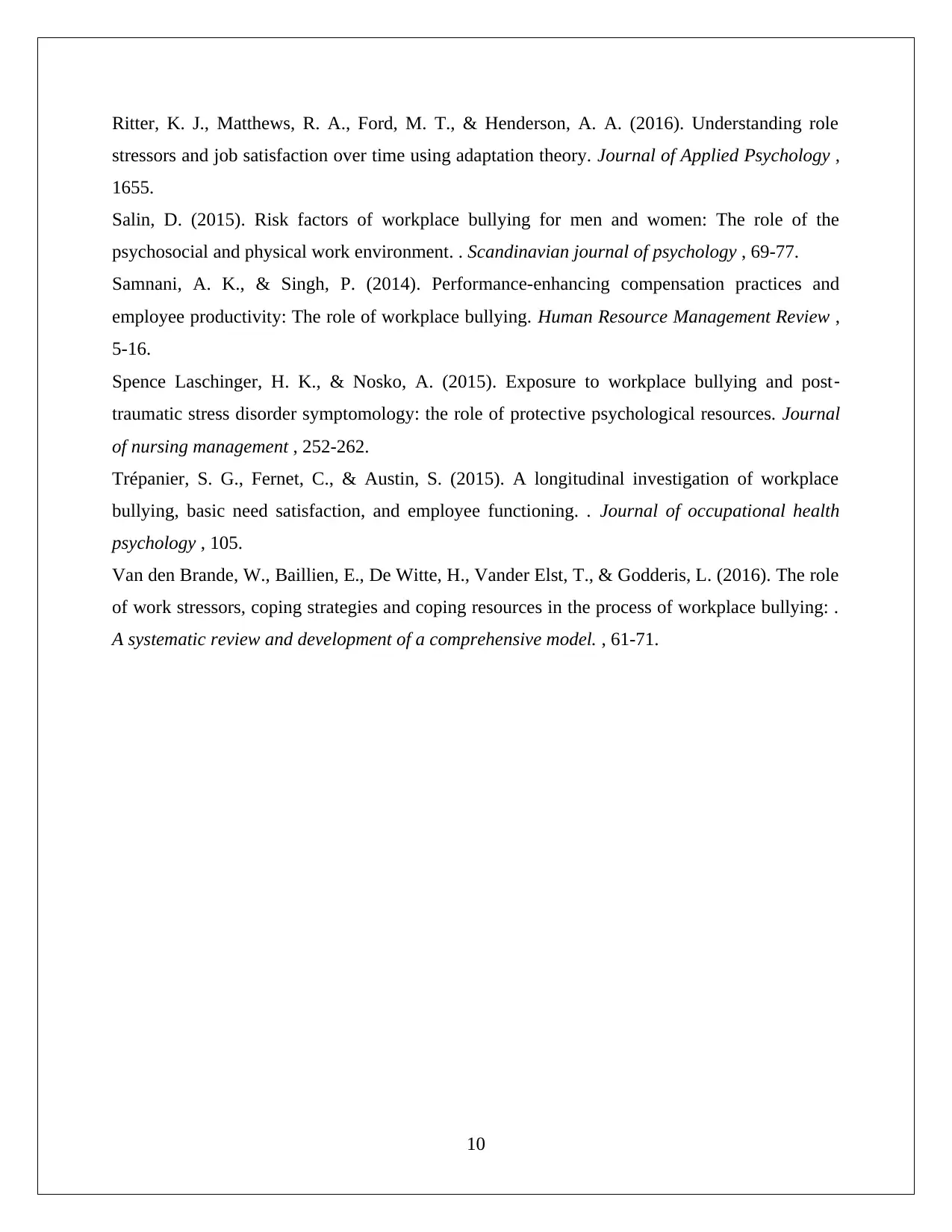
Ritter, K. J., Matthews, R. A., Ford, M. T., & Henderson, A. A. (2016). Understanding role
stressors and job satisfaction over time using adaptation theory. Journal of Applied Psychology ,
1655.
Salin, D. (2015). Risk factors of workplace bullying for men and women: The role of the
psychosocial and physical work environment. . Scandinavian journal of psychology , 69-77.
Samnani, A. K., & Singh, P. (2014). Performance-enhancing compensation practices and
employee productivity: The role of workplace bullying. Human Resource Management Review ,
5-16.
Spence Laschinger, H. K., & Nosko, A. (2015). Exposure to workplace bullying and post‐
traumatic stress disorder symptomology: the role of protective psychological resources. Journal
of nursing management , 252-262.
Trépanier, S. G., Fernet, C., & Austin, S. (2015). A longitudinal investigation of workplace
bullying, basic need satisfaction, and employee functioning. . Journal of occupational health
psychology , 105.
Van den Brande, W., Baillien, E., De Witte, H., Vander Elst, T., & Godderis, L. (2016). The role
of work stressors, coping strategies and coping resources in the process of workplace bullying: .
A systematic review and development of a comprehensive model. , 61-71.
10
stressors and job satisfaction over time using adaptation theory. Journal of Applied Psychology ,
1655.
Salin, D. (2015). Risk factors of workplace bullying for men and women: The role of the
psychosocial and physical work environment. . Scandinavian journal of psychology , 69-77.
Samnani, A. K., & Singh, P. (2014). Performance-enhancing compensation practices and
employee productivity: The role of workplace bullying. Human Resource Management Review ,
5-16.
Spence Laschinger, H. K., & Nosko, A. (2015). Exposure to workplace bullying and post‐
traumatic stress disorder symptomology: the role of protective psychological resources. Journal
of nursing management , 252-262.
Trépanier, S. G., Fernet, C., & Austin, S. (2015). A longitudinal investigation of workplace
bullying, basic need satisfaction, and employee functioning. . Journal of occupational health
psychology , 105.
Van den Brande, W., Baillien, E., De Witte, H., Vander Elst, T., & Godderis, L. (2016). The role
of work stressors, coping strategies and coping resources in the process of workplace bullying: .
A systematic review and development of a comprehensive model. , 61-71.
10
1 out of 10
Related Documents
Your All-in-One AI-Powered Toolkit for Academic Success.
+13062052269
info@desklib.com
Available 24*7 on WhatsApp / Email
![[object Object]](/_next/static/media/star-bottom.7253800d.svg)
Unlock your academic potential
Copyright © 2020–2025 A2Z Services. All Rights Reserved. Developed and managed by ZUCOL.





